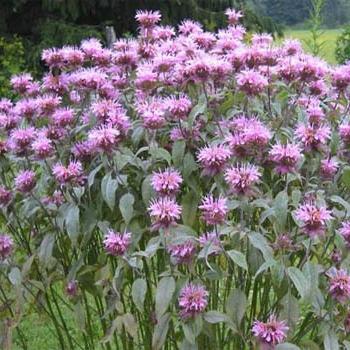A fragrant monarch is a plant that will charm everyone
Monarda is a plant of the labiate family, whichincludes more than 20 species of one -, perennial grasses. The bulk of flowers in the wild is found in America in the territory from Mexico to Canada. Its name was acquired by the name of the Spanish botanist, who discovered it in the 16th century. There are other popular names for the herb: horse mint, bee balm, wild bergamot, which did not appear in an empty place. Monarda is a melliferous plant, and it is constantly visited by bees and butterflies. However, a strong aroma exudes not only flowers, but also leaves that smell depending on the variety with mint, lemon or bergamot. Particularly tastes fragrant in hot sunny weather, if you rub the leaves in your hands. The whole plant is impregnated with essential oil substances. A juice of fresh leaves, containing a large amount of thymol, is used externally for wound healing.
Monarda is a plant that has a tetrahedral straight linea stem whose height reaches a meter. The underground part of the grass has a long rhizome, which allows the plant to grow in all directions. Leaves oblong, lanceolate, with jagged margins, slightly lowered, to shoots join short petioles opposite each other.
Blossoming monard begins in late June andlasts until the end of August. Undoubted adornment is bright colorful capitate globular inflorescences, which are located on the very tops of shoots. Depending on the variety, flowers are given a white, pink, red, crimson or yellow color. Each plant has in its composition up to 10 inflorescences, each of which has about 200 flowers. The bracts, having a similar color, give a special appeal and expressiveness to the bilabiate tubular flowers.
Monarda is a plant that is sufficiently resistant to pests, with the appearance of aphids or powdery mildew, treatment with chemical preparations will be required.
The fruits of the grass are dry, the small ones crack onfour parts, in the form of nuts. Seeds, depending on the weather, ripen in August or September. The vegetative period lasts until the onset of cold weather. Wild bergamot makes peace with penumbra, but still prefers the abundance of the sun. And on the shaded areas near the grass, a smaller number of inflorescences develop.
Monarda - the plant is quite aggressive. In an effort to possess the adjacent territories, it spreads through underground shoots and sprouts from the crumbling seeds. Once in 3-4 years, it is necessary to produce the division of bushes, since the central part of the plant falls out, and as a result, its decorativeness is lost.
Monard is quite resistant to cold, andit is possible to cultivate the plant even in the conditions of the Leningrad Region. The culture is undemanding to the composition of the soil, but prefers light calcareous soils. Heavy acidic marshy land for cultivation is not suitable. During the growth period, the fertilizing of the plant with organic and mineral fertilizers will not interfere.
One of the most common varietiesis a monarcha of a doorman. It is a perennial herbaceous variety, reaching a height of 120 cm has pubescent hairs, dentate leaves. Small lilac flowers are collected in globular heads, which are located on the tops of shoots and are surrounded by bracts of a reddish hue. Each stalk has up to nine inflorescences of 7 cm diameter, which include up to 260 flowers.
Another fine variety is the monarch Cambridge Scarlet. The plant has blood-red capitate inflorescences and reaches a meter height. The grass exudes a delicate aroma with a touch of bergamot.
Planting a plant in your garden, no florist will be disappointed, and the fragrance of the monarch will please the whole district.
</ p>


